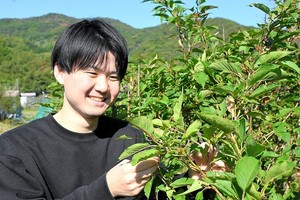By HONOMI HOMMA/ Staff Writer
September 24, 2023 at 08:00 JST
Trying to keep up with global trends, museums in Japan have started offering tours that allow visually impaired visitors to touch scale models and replicas of the original exhibits.
The National Museum of Emerging Science and Innovation (Miraikan) in Tokyo’s Koto Ward started hosting “touch tours” in March this year for visually impaired guests.
On July 9, three families joined the Miraikan tour. Their hands were guided to touch a scale model of the International Space Station while they listened to explanations about the exhibit.
“I had always wanted to know many things about it (ISS), like what shape it has, because I have never seen it before,” said Saori Sasaki, an 11-year-old fifth-grader from Tokyo’s Nerima Ward who has been blind since birth.
A “science communicator” or other special staff member takes the tour participants around the museum for about two hours.
According to science communicator Kodai Sano, the museum initially used visual information alone for its exhibits related to space, science, modern technologies and other themes.
But it realized the concepts of many displays were difficult to relay through only this approach.
So, staff members devised ways to help visitors gain a better understanding of the exhibits through touch. They later “started incorporating opinions of people with disabilities,” Sano said.
Their efforts accelerated after Chieko Asakawa, who is blind, took over as director in 2021.
Miraikan saw an increase in visitors using white canes or guide dogs who were rarely seen at the museum before, Sano added.
The Wakayama Prefectural Museum has replicas of Buddhist statues and catalogues printed with braille so that visually impaired guests can touch the historical materials.
The Wakayama museum came up with the idea 14 years ago after hearing a teacher at a local school for blind students say there were no materials from which students could learn the history of their hometown.
Tomoyuki Okochi, 49, an associate professor at Nara University’s Department of Cultural Heritage Studies, was working at the Wakayama museum at the time.
He said the museum produced replicas of Buddhist statues with the help of the prefecture-run Wakayama Technical High School, which had a 3-D printer, and other institutions.
“It is quite effective to obtain information through touch when it was previously possible through sight alone,” Okochi said.
ADVANCED EFFORTS OVERSEAS
According to the Japanese Association of Museums, exhibits at museums catering to the needs of visually impaired people have increased in the past two to three decades.
However, some experts say museums abroad have taken further steps to assist disabled visitors.
Toshiaki Aomatsu, 53, head teacher at the Special Needs Education School for the Visually Impaired, University of Tsukuba, in Tokyo, has escorted his students for training programs and other purposes to about 40 countries, including European nations and the United States.
He said visually impaired-friendly exhibits and contact points are offered as a matter of course in many places abroad.
In the United States, Smithsonian museums host touch tours for visually impaired visitors, while many museums in France and Germany display touchable exhibits.
Guides at other museums provide detailed verbal descriptions of the displays.
There are relatively few museums in Japan that help visually impaired guests through touch and audio guides.
Aomatsu said it is difficult for his school to give students a fulfilling tour experience unless the school makes suggestions to the museum.
“Museum exhibitions are meant to be seen,” said Kojiro Hirose, a professor at the National Museum of Ethnology in Osaka Prefecture who is blind. “And I assume that thinking about how to deal with visually impaired people will serve as a starting point to turn museums into places that everyone can enjoy.”




















A peek through the music industry’s curtain at the producers who harnessed social media to help their idols go global.
A series based on diplomatic documents declassified by Japan’s Foreign Ministry
Here is a collection of first-hand accounts by “hibakusha” atomic bomb survivors.
Cooking experts, chefs and others involved in the field of food introduce their special recipes intertwined with their paths in life.
A series about Japanese-Americans and their memories of World War II